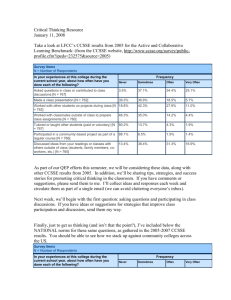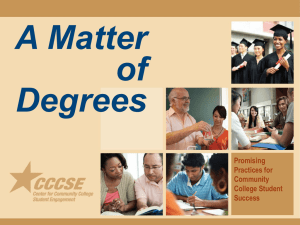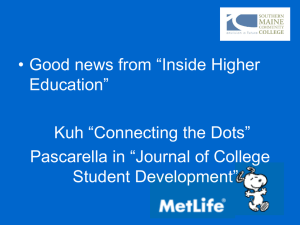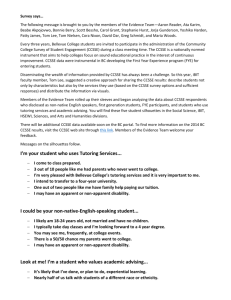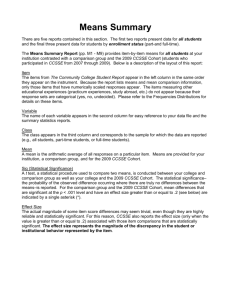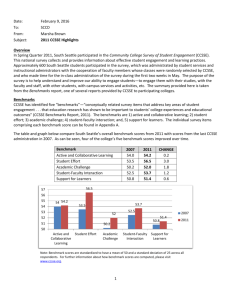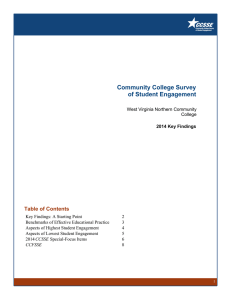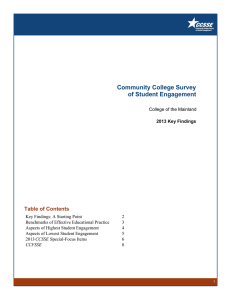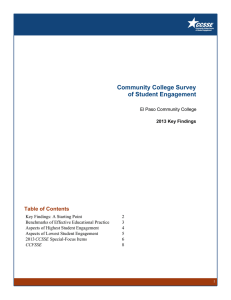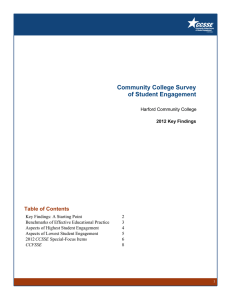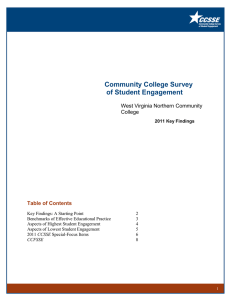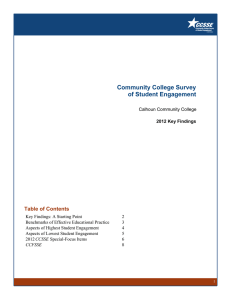High-impact Educational Practices: What are they?
advertisement
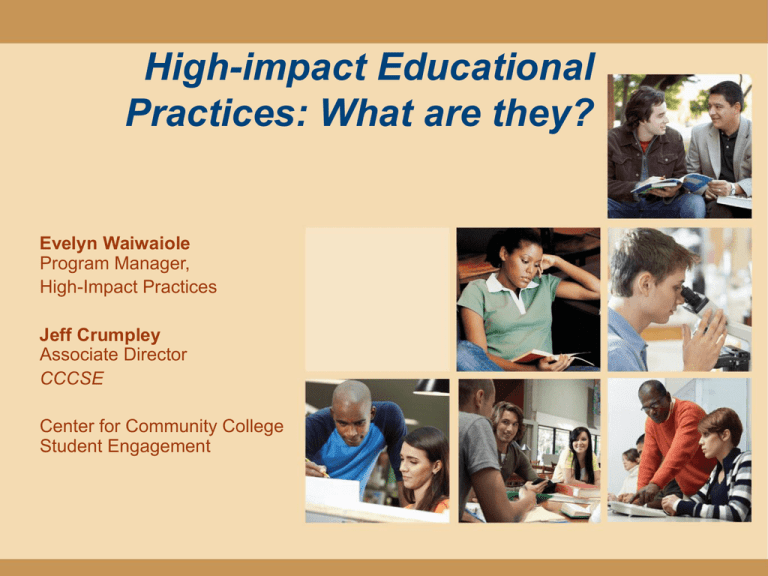
High-impact Educational Practices: What are they? Evelyn Waiwaiole Program Manager, High-Impact Practices Jeff Crumpley Associate Director CCCSE Center for Community College Student Engagement Identifying and Promoting High-Impact Educational Practices in Community Colleges 3 Year Initiative Funded by the Bill and Melinda Gates Foundation and Lumina Foundation Analyze data from four surveys Focus groups Institutes National Reports Initiative ends August, 2014 2 CCCSE: Collecting Data from Many Perspectives Four surveys that complement one another: CCSSE CCFSSE SENSE CCIS 3 CCCSE: Collecting Data from Many Perspectives 4 CCCSE: Collecting Data from Many Perspectives Qualitative and quantitative data Surveys provide quantitative data. Focus groups from the Initiative on Student Success and High-Impact Practice Initiative provide qualitative data. 5 CCCSE: Collecting Data from Many Perspectives Core surveys and special-focus items Core surveys are the same from year to year. Special-focus items examine a specific area and change from year to year. Special-focus items for the 2011 and 2012 surveys address promising practices for promoting student success and completion. 6 CCSSE High Impact Practices Early Results Promising Practices for Community College Student Success Planning for Success: Assessment and Placement, Orientation, Academic Goal Setting and Planning, and Registration before Classes Begin Initiating Success: Accelerated or Fast-Track Developmental Education, First-Year Experience, Student Success Course, and Learning Community Sustaining Success: Class Attendance, Alert and Intervention, Experiential Learning beyond the Classroom, Tutoring, and Supplemental Instruction 8 CCFSSE High Impact Practices CCFSSE Promising Practice Items combined with Student responses 11% of CCSSE respondents reported that they registered for class after the first class session has started. Yet, 62% of faculty responders say that at least one student registered late for a class 10 SENSE High Impact Practices SENSE Promising Practice Items Entering students and class attendance All Instructors Explain Class Attendance Policy Class Attendance In The First Three Weeks 26% 23% Not Skipped Skipped YES NO 77% 74% 12 What students say about skipping class 13 CCIS High Impact Practices CCIS, CCSSE, CCFSSE Promising Practices Promising Practice Colleges That Report Having It Students Who Report Doing It Full-Time Faculty Who Teach or Facilitate Orientation 96% 58% 13% Student Success Course 83% 24% 12% First-Year Experience 58% 26% 17% Learning Community 56% 13% 16% Accelerated Developmental Education 42% 26% 14% 15 Students are not always well-informed 16 Supplemental Instruction • Students who use it 19% • Faculty who make it available 44% • Colleges that offer it 87% • New Trend?? - 14% of CCIS colleges report mandatory SI for all developmental education students 17 A Student Speaks about SI 18 CCIS High Impact Practices How does student participation in these promising practices show up in CCSSE benchmark scores? 2011 CCSSE Benchmark Scores by Registration – Promising Practice Item #1 50.5 49.6 Active and Collaborative Learning 51.1 50.1 47.9 Student Effort Registered for all courses before the first day of class 50.1 49.2 47.1 Academic Challenge Student-Faculty Interaction 50.0 48.1 Support for Learners Registered late Sources: 2011 CCSSE data 20 2011 CCSSE Benchmark Scores by Orientation – Promising Practice Item #2 52.3 52.8 52.3 47.8 47.2 53.4 52.7 47.8 47.7 45.7 Active and Collaborative Learning Student Effort Participated in Orientation Academic Challenge Student-Faculty Interaction Support for Learners Did not Participate in Orientation Sources: 2011 CCSSE data 21 Views of Orientation 22 2011 CCSSE Benchmark Scores by FYE – Promising Practice Item #3 54.8 55.7 54.8 48.8 Active and Collaborative Learning 57.1 53.5 48.7 Student Effort Participated in First Year Experience 49.7 Academic Challenge 48.7 Student-Faculty Interaction 47.6 Support for Learners Did not participate in First Year Experience Sources: 2011 CCSSE data 23 2011 CCSSE Benchmark Scores by Learning Comm. – Promising Practice Item #4 59.1 58.6 59.4 56.8 54.6 49.0 Active and Collaborative Learning 49.3 Student Effort Participated in Learning Community 50.0 Academic Challenge 49.3 Student-Faculty Interaction 48.7 Support for Learners Did not Participate in Learning Community Sources: 2011 CCSSE data 24 Impression of a first year learning community 25 2011 CCSSE Benchmark Scores by SSC – Promising Practice Item #5 57.8 56.1 54.9 55.9 53.9 48.9 Active and Collaborative Learning 48.5 Student Effort Participated in Student Success Course 49.7 Academic Challenge 48.8 Student-Faculty Interaction 47.7 Support for Learners Did not Participate in Student Success Course Sources: 2011 CCSSE data 26 Student Success Courses 27 High Impact Practices: What comes next? CCIS High Impact Practices: Next steps Analysis of components inside of each promising practice Analysis of the relationship between each promising practice and self-reported GPA Analysis of the relationship between each promising practice and student records Deeper looks at college specific programs with successful results 29 Questions ? Visit Booth #209 in the Exhibit Hall Center for Community College Student Engagement 3316 Grandview Street Austin, Texas 78705 Phone: 512-471-6687 www.ccsse.org
